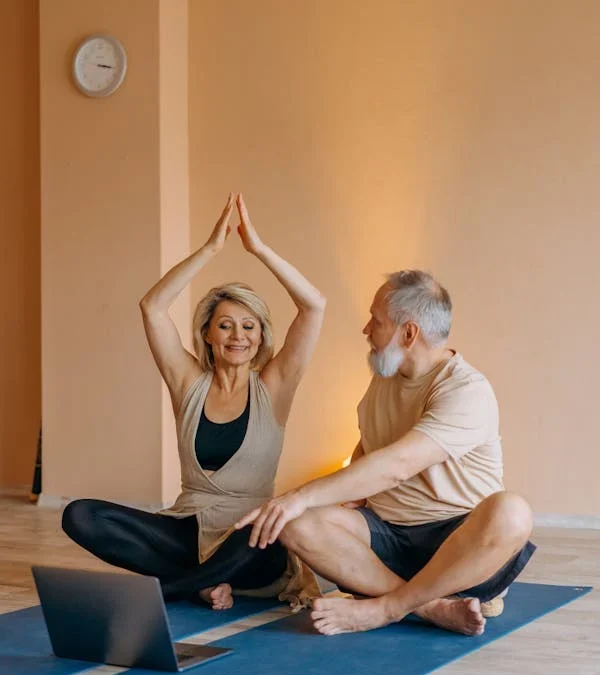As we age, maintaining flexibility and balance becomes essential for overall health, independence, and reducing the risk of falls. Incorporating simple exercises into your daily routine can significantly improve mobility, coordination, and strength, helping older adults stay active and confident in their movements.
Why Focus on Flexibility and Balance?
- Prevention of Falls: Falls are one of the leading causes of injury among older adults. Improved balance reduces this risk.
- Improved Mobility: Flexibility helps maintain a full range of motion, making daily activities like bending, reaching, or walking easier.
- Increased Independence: Staying active and mobile allows older adults to perform tasks without assistance.
- Pain Management: Flexibility exercises can alleviate joint stiffness and reduce pain associated with arthritis or other conditions.
Flexibility Exercises for Older Adults
Flexibility exercises are designed to gently stretch the muscles and improve joint mobility. Aim to include these stretches in your routine 2–3 times per week.
- Neck Stretch
- Sit upright in a chair.
- Slowly tilt your head to one side, bringing your ear toward your shoulder.
- Hold for 10–15 seconds, then switch sides.
- Seated Hamstring Stretch
- Sit on the edge of a chair with one leg extended straight in front of you.
- Keep your back straight and lean forward slightly.
- Hold for 15–20 seconds, feeling a stretch in the back of your thigh.
- Shoulder Rolls
- Sit or stand upright.
- Roll your shoulders backward in a circular motion 8–10 times, then forward.
- Cat-Cow Stretch
- Start on your hands and knees.
- Arch your back upward like a cat (Cat Pose) and then gently lower your back, lifting your head (Cow Pose).
- Repeat 5–10 times, moving slowly.
Balance Exercises for Older Adults
Balance exercises strengthen stabilizing muscles and improve coordination. Perform these exercises 2–3 times weekly, or more if comfortable.
- Heel-to-Toe Walk
- Walk in a straight line, placing the heel of one foot directly in front of the toes of the other.
- Use a wall or sturdy furniture for support if needed.
- Perform 10–15 steps forward and then return.
- Single-Leg Stand
- Stand behind a chair for support.
- Lift one foot off the ground and balance on the other leg.
- Hold for 10 seconds, then switch legs.
- Gradually increase the duration as your balance improves.
- Side Leg Raises
- Hold onto a sturdy chair or wall for balance.
- Slowly lift one leg out to the side, keeping your toes pointing forward.
- Lower the leg and repeat 8–10 times, then switch sides.
- Tai Chi or Yoga
- Join a beginner class or follow a video tailored to older adults.
- These practices promote balance, coordination, and relaxation.
Safety Tips for Exercise
- Warm Up First: Always start with 5–10 minutes of light activity, such as walking or gentle arm swings.
- Use Support if Needed: Perform balance exercises near a sturdy chair, wall, or counter.
- Listen to Your Body: Avoid pushing yourself too hard or continuing if you feel pain.
- Stay Consistent: Regular practice is more beneficial than occasional effort.
- Consult Your Doctor: Before starting any new exercise program, speak with your healthcare provider to ensure the exercises are appropriate for your fitness level and any existing health conditions.
Building a Routine
Incorporate flexibility and balance exercises into your daily routine to make them a habit. For example:
- Morning Stretch: Start your day with gentle stretches to loosen up stiff muscles.
- Afternoon Walk: Combine balance exercises with a short walk around your neighborhood.
- Evening Cool Down: Perform seated stretches before bed to relax your body and mind.
There are many exercises above that will make a difference in your flexibility, balance, and overall health and wellbeing. Please understand that you don’t have to do all the exercises every day. Start with the exercises that you like or are easy to perform and slowly build into some of the more difficult stretches and balance poses as you progress. Take your time with this, have fun and challenge yourself from time to time. If you feel stiff or sore the next day lightly stretch the tender area and even take a day off if needed. Flexibility and balance exercises are vital for older adults to maintain independence, reduce the risk of injury, and enjoy a higher quality of life. By dedicating just a few minutes each day to these exercises, you can improve your physical health and confidence. Remember, it’s never too late to start, so lace up your comfortable shoes, grab a sturdy chair, and begin your journey to better balance and flexibility!
Click here to buy Be Simply Fit

